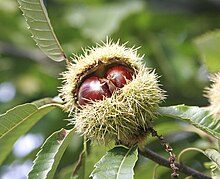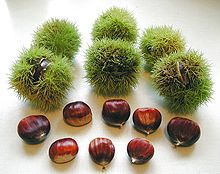Castanea sativa
The chestnut (Castanea sativa) is a tree that belongs to the fagaceae family, whose fruit, the chestnut, is edible and it was an important food source, particularly in some regions of southern Europe.
Description
Trees up to 25-30 m tall, with a straight, short, thick trunk (up to 2 m in diameter) and smooth, ashen or brownish bark up to 15-20 years old, then dark-brown and longitudinally cracked with glabrous twigs, brown-green
Buds ovoid, obtuse, the terminals absent. Leaves 8-22 by 4.5-8 cm, oblanceolate, acute, with a slightly asymmetric rounded base, serrated, with sharp teeth, glabrous on the upper side and slightly pubescent along the veins on the underside.
Male flowers in catkins up to 20 cm long, with double trimerous perianth, and with 8-12 exserted stamens surrounding a rudimentary sterile ovary (pistilode); females with 7-9 styles at the apex of the ovary, apex covered with appressed silky hairs that extend to the base of the styles, and will persist in the achene derived from said ovary.
The fruit is a subglobose cupola covered with long branched and somewhat hairy spines (calibio) that measures between 5-11 cm in diameter, dehiscence by 4 valves and usually contains 2-3 achenes that are the chestnuts themselves. Said achenes, although it can also be interpreted as a "nut", in the botanical sense of the term, measure about 2-4cm; They have a domed shape towards the outside and a flat inner face (when there are more than 2, both sides of the central ones adopt a flattened shape). The base, convex or planoconvex, of each one presents a wide greyish scar (Thread) that corresponds to its attachment to the outer dome, and preserves the hairy pistil and its styles at the apex. The endocarp, which is the integral "skin"outer shell, although it may present dehiscence due to rupture, is dark brown ("chestnut") with somewhat darker longitudinal bands; it is shiny, practically smooth with imperceptible longitudinal irregular grooves from the thread (excluded) almost to the apex. Its underside is abundantly hairy/velvety, with long, sinuous whitish hairs. Said endocarp surrounds the seed, which is ruminated, without endosperm and surrounded by a cinnamon-colored integument (episperm), irregular and closely attached to the cotyledons, penetrating the fissures and irregularities of their surfaces. This seed is the edible part of the chestnut.
Distribution
It is native to southern Europe and Asia Minor. It forms forests on cool, moist soils. Introduced for cultivation, and occasionally naturalized, in many countries around the world, including Australia and New Zealand.
In the Iberian Peninsula, as well as in Spain, we can find it in the north and center of Portugal, although in this country there is a tendency to make new plantations with Japanese chestnut, which is more resistant to diseases.
In France it is very frequent in the Massif Central, Corsica and the Paris region, although its cultivation is largely abandoned, and it is almost always in non-grafted chestnut forests.
In Italy it extends throughout the peninsula, the area at the foot of the Alps in Piedmont and Lombardy, in the Barbagia of Sardinia and in mountainous areas of Sicily. It also appears in the south-east of England; and in the Palatinate, the Odenwald, and regions around the Upper Rhine Valley in Germany.
We can find it in the eastern region of Styria (Austria) or in the Transdanube (Hungary), as well as in some regions of southern Moravia (Czech Republic), or some areas of southern Slovakia. It is present in the western part of Romania, around the Iron Gates of the Danube, as well as in Serbia. It is a common tree in northern Greece.
Chestnut trees in Spain
In Spain it is especially abundant in Asturias and Galicia (mainly in the provinces of Lugo and Orense). It is also very common in the western part of León, especially in El Bierzo and La Cabrera, with some impressive specimens in the Montes Aquilianos, near Ponferrada, Las Médulas or Los Ancares; It also appears in the Sanabria, Carballeda and Aliste mountains south of Salamanca (Peña de Francia, Sierra de Béjar, Quilamas) and south of Ávila, Valle del Tiétar and Castañar del Tiemblo). There are some specimens in the north of Burgos, region of the Merindades.
It is a frequent tree in the Basque Country (mainly Vizcaya and Guipúzcoa). Although in these areas, its cultivation does not have the importance that it has traditionally had in Asturias, Galicia or León, where until not many decades ago it was a staple food in mountain areas.
In Extremadura we find it in the mountains to the north of Cáceres (Hurdes, Sierra de Gata, Valle del Jerte and the region of La Vera), in Las Villuercas and in the foothills of Sierra Morena, south of Badajoz.
In Castilla-La Mancha it appears in the Sierra de San Vicente, in Los Ibores and La Jara, province of Toledo; and in Sierra Madrona, Ciudad Real. It is absent in the provinces of Albacete, Cuenca and Guadalajara.
We can find chestnut trees in the southwest of the Community of Madrid, in the municipality of Cadalso de los Vidrios. It is absent, however, in other mountainous areas further north in the province.
In Aragon chestnut appears in a very localized way in some siliceous mountains of the Zaragoza Iberian system (Algairen, Moncayo or Herrera, Luesma). There are no chestnut groves in the Huesca Pyrenees or in Teruel.
In La Rioja an isolated specimen appears in the region of Cameros.
In Catalonia, chestnut is very abundant in the province of Gerona (Garrocha, La Selva, Alt Ampurdán), some mountains in the northeast of Barcelona (Valles Oriental, Osona, coastal mountains of Maresme) and in the province of Tarragona, the isolated nucleus of the Prades mountains, Poblet forest. It does not appear in the western regions of Barcelona, nor in Lérida.
In the Valencian Community there are some specimens in the Sierra de Espadán, around Almedijar, Ah!, and Alcudia de Veo, Algimia de Almonacid. It is a totally isolated and very scarce population, unknown to the majority of Valencians. It does not appear anywhere else in the Community.
In Murcia it is completely absent, but it reappears in the Alpujarras, both in Almería and Granada. It is present in the Ronda mountains and the mountains of the Alcornocales natural park, between Málaga and Cádiz. In Sierra Morena it appears in Huelva (Sierra de Aracena), Sierra Norte de Sevilla and some areas of the Sierra Morena Cordoba.
There is a monumental specimen in the hills of Sierra de Benzú (Ceuta).
Similarly, there are chestnut groves in Gran Canaria, Teror (Osorio chestnut grove, described by Miguel de Unamuno), Tenerife and the north of the Canary Islands, in areas formerly occupied by laurel (as is the case on the Portuguese island of Madeira).
Cultivation
This species requires a mild climate and adequate humidity for its growth and the production of nuts. It is sensitive to strong summer droughts and severe winter frosts, harming it in late spring and early autumn frosts. It likes siliceous soils, it does not tolerate limestone soils. In wooded habitats it can tolerate light shade; does well on somewhat cool but hot mountain slopes during the summer, when its fruits form.
In recent times, this great tree has regressed enormously, due, in large part, to two terrible plagues: ink and canker, but its enormous vitality and the ability to regrow its vine ensure the survival of many chestnut groves.
Uses
The chestnut tree is widely cultivated for its tasty edible fruits, chestnuts, which are eaten raw or roasted and used by confectioners. The chestnut has been a food resource of the highest order in many places, in the past they were consumed throughout the year, but progress, the introduction of new crops and the change in eating habits threaten their good reputation and prominence.
In November, these colossal trees drop their precious fruit, for the enjoyment of forest animals, and so that humans do not miss the opportunity to collect chestnuts. In Roman times it was introduced to more northern regions and later cultivated by monks in monasteries. Specimens dating back several centuries can now be found in Great Britain and throughout central and western Europe, and in southern South America, in Chile.
Its durable wood is used to make furniture, stakes for plants, beams for decoration and construction, barrels and fences, gaff hooks for tuna fishing. Its leaves, which are among the easiest to recognize of all trees, have been used in animal feed.
- Medicines
The leaves are used as an expectorant, antitussive, astringent, antidiarrheal, antipyretic and antirheumatic. The bark is astringent. The leaves febrifuge, astringent.
Indicated for stomatitis, periodontal disease, pharyngitis, bronchitis, irritative cough, flu, colds, diarrhea.
Tannins can cause digestive discomfort, especially in patients with hypersecretory dyspepsia. To alleviate this possible side effect, it is recommended to administer herbal teas associated with drugs with mucilages, such as marshmallow.
Taxonomy
Castanea sativa was described by Philip Miller and published in The Gardeners Dictionary:... eighth edition no. 1, 1768.
- Etymology
- Castanea: generic name derived from the Greek χετανον And then the Latin castăněa, -ae, name of chestnut and chestnut (Virgilio, Bucolicas,1, 82), the latter also called castanea nux (Virgilio, Bucolicas, 2, 52), the walnut of the chestnut. It could also derive from Castanaea, ae or Castana, ae, city of Asia Minor or, according to others, of the Armenian name of this tree.
- sativa: Latin epithet that means "cultured".
- Sinonimia
- Castanea Castanea (L.) H.Karst.
- Castanea prolifera (K.Koch) Hickel
- Castanea sativa f. discolor Vuk.
- Castanea sativa var. hamulata A.Camus
- Castanea sativa var. microcarpe Lavialle
- Castanea sativa var. prolifera K.Koch
- Castanea sativa var. spicata Husn.
- Vesca Castanea Gaertn.
- Castanea vulgaris Lam.
- Fagus castanea L.
- Fagus castanea var. variega Weston
- Fagus procera Salisb.
Common names
Its common name in Spanish includes: bravas, chestnut, chestnut, castañal bravo, chestnut, chestnuts, castañas bravas, chestnuts (fruit), castañeda, castañeiro, castañero, chestnut, brave chestnut, common chestnut, male chestnut, molar chestnut, real chestnut, regoldano chestnut, regoldo chestnut, regueldo chestnut, wild chestnut, wild chestnut, chestnut, shell, concho, engertos, hedgehog, molso, morso, common reboldanos, reboldos, regoldana, regoldanos, regoldo, regoldonas, regoldos, sanmartiniegos, tagarnizos, valdunas, zapatonas.
Contenido relacionado
Cyclocarpales
Capparaceae
Araliaceae








